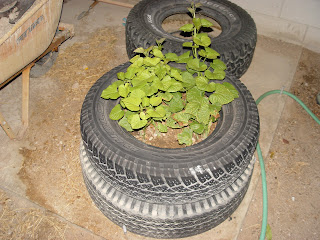I have found that when you have poor soil, like I did in these beds last year, you have more water stress in the heat of the summer, weaker plants and a greater likelihood of disease and insect pests. It's nature's way of making sure that we feed the soils. I don't expect the same type of problems to anywhere near that degree this year.
I grew some green manure crops of peas and beans and turned all that matter into the soil. I supplemented with an untold amount of leaves this last fall and several bags of compost from the garden center. We also mulched with alfalfa last year and turned that all in when we dug the beds. I am mulching with straw this year and am growing worms in my worm bed. I hope with all of that, my yields should be higher and my plants should be healthier. Feed the soil and the soil feeds the plants.
Here is a cantaloupe hiding under one of the eggplant bushes.
These guys got really big really fast. It was amazing to me to see how fast they would grow in a week. They could go from flower to harvest-able fruit in less than 2 weeks. Now all I have to do is get my wife and kids to like to eat eggplant. Time to get creative in the kitchen.
This was a fun experiment that actually failed, but it was fun to watch and see the progress as far as it went. These are sweet potatoes growing in some soil-filed tires. I had told my daughters that you could grow spuds in tires and they went out and found some tires to try it. We planted Yukon Gold potatoes at first, and they grew very nice tops and we even got to add the second tire to it, but the dogs decided that they wanted to see what was down there and dug them up and basically destroyed everything but the tires. So we tried it again with the sweet potatoes (we had some that had developed slips) but we didn't have enough of the season left and they produced not new tubers.
We'll do it again, but maybe not in tires.
If you try this, get a jig saw and cut off the sidewalls of the tires before you plant. That makes it more of a barrel and it is easier to break down in the fall when you harvest. It also removes a serious place for black widows to hide, a real concern in the desert.
Mmmm, melons. Now THAT's breakfast!
Corn in the front, beans behind and tomatoes in the distance.
Some of the doomed squash. Great flowers, terrific plant growth and way, way too much fruit.
This one 3-year-old almond tree produced nearly 3 pounds of almonds this past season, the first time it has produced. Some are weirdly shaped, but they sure taste good.
Another melon hiding in the leaves. Love these things.
This is actually only two watermelon plants on the second level. The vines would grow over the side and cascade down to the level below and then on to the ground level.This is one day's harvest from the garden last year. Lots of tasty eggplant, several over-sized zucchini, a couple of yummy crookneck squash and 4 cucumbers. The pale green ones are Armenian cucumbers, a giant variety that makes great salads and is wonderful for eating, but silly for pickles. The one with the darker speckles is what happens when you grow "regular" cucumbers close enough to be cross-pollinated by the Armenians. It made for an interesting color and pattern, but the flavor was wonderful.
I like growing unusual plants like those giant cucumbers. They make great conversation pieces at work when you bring in produce to share.















No comments:
Post a Comment